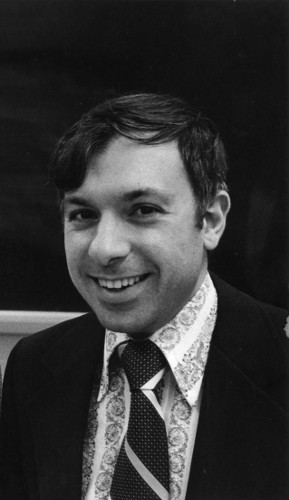 Yervant Terzian, 1970s (Cornell University photo)
Yervant Terzian, 1970s (Cornell University photo)
Yervant Terzian
Contributed by Bruce Balick, Don Campbell, George Helou
Professor Yervant Terzian of Cornell University passed away peacefully in the early hours of November 25, 2019, after a long and debilitating illness. Prof. Terzian (hereafter "Yervant") made major contributions to the field of astronomy, including 235 published papers spanning fifty-six years, mainly in various fields of radio astronomy that he helped to pioneer during his long career. He was an active and always extremely enthusiastic member in his research communities, an inspired teacher, and a gifted administrator. Yervant is probably best remembered for his tremendous capability to infect both students and everyone he knew or met with his deep and genuine excitement and love for astronomy. Yervant is survived by his wife, Patricia Fernandez de Castro, children, Sevan and Tamar, and four grandchildren.
Yervant, an American astronomer of Armenian heritage, was born in Alexandria Egypt in 1939 and lived in Greece for much of his childhood. He completed his PhD studies in 1965 at Indiana University, primarily using new facilities at the National Radio Astronomy Observatory. Yervant then joined the scientific staff of the newly completed 1000-foot radio telescope at Arecibo Observatory and spent the remainder of his career there and, starting in 1967, on the faculty at Cornell. (The first author of this article was his first PhD student, very frequent collaborator, and - like many his other former students - remained in close contact with Yervant until his death. I shall always treasure his sincere interest, thoughtfulness, and timely advice during our long friendship.)
Yervant is best known to astronomers for his pioneering papers on the radio emission of H II regions, planetary nebulae, and normal galaxies. His first refereed paper, "Radio Radiation from Normal Spiral Galaxies," appeared in the ApJ in 1967 and the last, "SIGGMA: A Survey of Ionized Gas in the Galaxy, Made with the Arecibo Telescope," was published in the AJ in 2013. Starting in the 1980s Prof. Terzian worked with George Helou, Steve Schneider, and Edwin Salpeter, his students, and many others on studies of intergalactic HI clouds in clusters, binary-galaxy dynamics, and rotation curves of galaxies in pairs and groups using Arecibo.
Terzian began as Chair of the Astronomy Department in 1979, a position that he held for 20 very productive years. He was also a Scientific Editor for the Astrophysical Journal starting in 1989. However, the achievement of which he was most proud was raising over two million dollars for the Armenian National Science and Education Fund, a fund that launched many successful research projects in his adopted home country. In addition many awards and honors, Prof. Terzian was elected a Foreign Member of the Armenian Academy of Sciences in 1990 and received the Gold Medal, the "highest honor for scientific achievement," from the Government of the Republic of Armenia in 2008. See https://astro.cornell.edu/yervant-terzian for additional information about his many professional awards and distinguished community service.
![[IAU logo]](iau_wb_thumb.jpg)
![[URSI logo]](URSI-logo-thumb.jpg)
![[Karl Jansky at his antenna]](jansky_photo_02_thumb.jpg)
![[Reber's Wheaton antenna]](Reber_Telescope_Wheaton_thumb.jpg)
![[Dover Heights]](Dover_Heights_02_thumb.jpg)
![[4C telescope]](GB61-195_4C_telescope_thumb.jpg)
![[Ewen and horn antenna]](ewen_horn1s.jpg)
![[Dwingeloo, 1956]](Dwingeloo-1956-thumb.jpg)
![[Jocelyn Bell Burnell and Cambridge antenna used in pulsar discovery]](burnell2_thumb.jpg)
![[Lovell Telescope at Jodrell Bank]](site_1594_0001-500-334-20180316163019-thumb150.jpg)
![[Wilson, Penzias, and Bell Labs horn antenna]](wilson-penzias-horn_thumb.jpg)
![[6-m Millimeter Radio Telescope in Mitaka, Japan]](6m-thumb.jpg)

